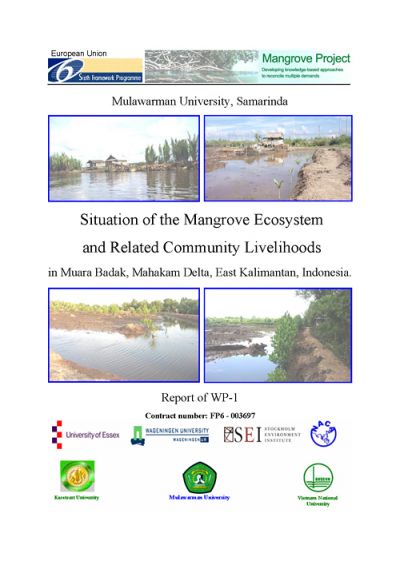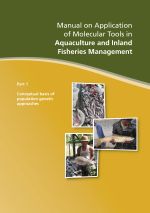Situation of the mangrove ecosystem and related community livelihoods in Muara Badak, Mahakam Delta, East kalimantan, Indonesia
22 August 2006 | 607 Downloads | .pdf | 1.98 MB | Gender, Genetics and biodiversity, Livelihoods, gender and social issues, Aquatic plants, Shrimp, Indonesia
The Mahakam delta covers close to 1100 km2 and is, except for it's land-side fringe, a collection of islands accessible by boat only. The original vegetation of this delta composed mainly of pure Nypa, mixed Nypa-Avicennia, pure Avicennia and Rhizophora, and some sparse Sonneratia populations, only remains on some sparse islands and inside concessions of oil and gas companies covering less than 10% of the delta. After the first cold storage company installed in 1970 farming of shrimp started in ponds dug manually or with excavators after 1990. During the economic crises of 1997 shrimp prices in local currency rose sky high and pond opening exploded. In 2001, 75% of the delta was covered with ponds of which around 1/3 was opened for speculation on future compensation by oil and gas companies. This stimulated extensive production methods in very large ponds in order to claim land. In 2003 the area of productive ponds was just above 45,000ha. Moreover in most cases the real pond size is must smaller than the actual area between the dikes as only the soil needed to make the dikes was excavated while the central plateau of most pond kept its' the original level. This might also explain the smaller productivity of the larger ponds. Since 2000 the white spot virus (WSSV) reduced pond productivity.
The three research sites are located in villages of the sub-district Muara Badak in the north of the delta. Site 1, Salo-Palai hamlet 2 and 3, includes about half of the island of Joppang, while site 2, Saliki hamlet 1, 2 and 3, includes the other half of Joppang; the third site regroups hamlet 7, 8 and 9 from Saliki and is located on the island of Taddutan. Except for an area of 1 ha, a small island and a narrow fringe of Nypah on the riverside, the mangrove cover in the research sites was replaced by fishponds. Farmers fear the consequences of erosion and abrasion on their pond dikes and on the water quality, and the reduced availability of seed for crab, fish and shrimp. The lack of breeding grounds and refuges for the fish is shared by the fishermen. Recently the land clearing for oil-palm plantation for the production of bio-fuel started. In 2007 a 10,000 ha plantation started in the district of Saliki.
In some hamlets located on the islands the population depends for 100% on the pond, but most others have a mixed population of workers for private companies, government officers, traders, land-less agricultural workers, fishermen and farmers. Only those households having a house on the mainland also farm dry land crops or keep livestock. Around 80% of the livelihood activities of the pond-farmers, pond care-takers, fishermen and farmers, is based on or related to the mangrove resource. The livelihood activities of the poorer households depends more the natural resource base. For pond farmers and care-takers, farming of shrimp, milkfish and collecting crab is the main source of income. The seasonality of the activities is relatively high as the ponds have 4 main harvests per year. Fishing and catching crab, give a more regular cash flow, but are only practised during high tide. Some started crab culture. The relative contribution of pond farming to livelihood is on average close to 50%, which makes the population highly vulnerable for decreasing pond productivity and for shocks in shrimp production like have occurred in the past. A main part of the population immigrated to make a livelihood and if pond farming does not provide this anymore they will, without any doubt, move again to replace still virgin natural resources with plantations or ponds. Improving and stabilising the shrimp production is of the greatest importance, also to reduce the dependency of the pond-farmers upon the products collectors that are at the same time input and credit providers as well as the main source of information on prices and new technologies.
In an attempt to re-establish the mangrove eco-system some pond owners started to replant mangrove, mostly on the pond-dikes which is probably not the best method. However this gives an opportunity to start action research with the farmers to establish the best ways to recover the mangrove eco-system and improve overall productivity. The main problem will be the involvement of the absentee owners that hire care-takers those that have non-producing ponds. These absentee owners of mostly larger ponds make the re-establishment of the mangrove more complex as they are not interested in a productive pond and are not aware of the eco-systems function. Re-establishing mangrove will bring forward the problem of ownership which is based on the area being a pond. Local authorities need to provide some kind of save-guard to secure the ownership or the right on compensation.
Publisher: Network of Aquaculture Centres in Asia-Pacific
Rights: Creative Commons Attribution.

